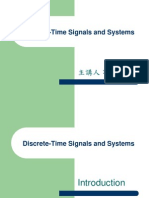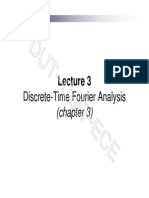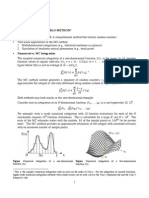Discrete-Time Signals and Systems: Gao Xinbo School of E.E., Xidian Univ
Discrete-Time Signals and Systems: Gao Xinbo School of E.E., Xidian Univ
Uploaded by
Nory Elago CagatinCopyright:
Available Formats
Discrete-Time Signals and Systems: Gao Xinbo School of E.E., Xidian Univ
Discrete-Time Signals and Systems: Gao Xinbo School of E.E., Xidian Univ
Uploaded by
Nory Elago CagatinOriginal Title
Copyright
Available Formats
Share this document
Did you find this document useful?
Is this content inappropriate?
Copyright:
Available Formats
Discrete-Time Signals and Systems: Gao Xinbo School of E.E., Xidian Univ
Discrete-Time Signals and Systems: Gao Xinbo School of E.E., Xidian Univ
Uploaded by
Nory Elago CagatinCopyright:
Available Formats
Chapter 2.
Discrete-Time Signals and Systems
Gao Xinbo
School of E.E., Xidian Univ.
Xbgao@ieee.org
http://see.xidian.edu.cn/teach/matlabdsp/
Main Contents
Important types of signals and their operations
Linear and shift-invariant system
Easier to analyze and implement
The convolution and difference equation
representations
Representations and implementation of signal
and systems using MATLAB
Discrete-time signals
Analog and discrete signals
analog signal
t represents any physical quantity, time in sec.
Discrete signal: discrete-time signal
N is integer valued, represents discrete
instances in times
) (t x
a
) (n x
} ), 1 ( ), 0 ( ), 1 ( , { )} ( { ) ( x x x n x n x = =
Discrete-time signal
In Matlab, a finite-duration sequence representation
requires two vectors, and each for x and n.
Example:
Question: whether or not an arbitrary infinite-duration
sequence can be represented in MATLAB?
} 7 , 3 , 4 , 1 , 0 , 1 , 1 , 2 { ) ( = n x
]; 7 , 3 , 4 , 1 , 0 , 1 , 1 , 2 [
]; 4 , 3 , 2 , 1 , 0 , 1 , 2 , 3 [
=
=
x
n
Types of sequences
Elementary sequence for analysis purposes
1. Unit sample sequence
Representation in MATLAB
{ } , 0 , 0 , 1 , 0 , 0 ,
0 , 0
0 , 1
) (
|
=
=
=
=
n
n
n o
2 0 1 2 1
0
0
0
, ,
, 0
, 1
) ( n n n n n n
n n
n n
n n s s s s
=
=
= o
Function [x,n]=impseq(n
0
,n
1
,n
2
)
A: n=[n1:n2];
x = zeros(1,n2-n1+1); x(n0-n1+1)=1;
B: n=[n1:n2]; x = [(n-n0)==0]; stem(n,x,ro);
-3 -2 -1 0 1 2 3
0
0.2
0.4
0.6
0.8
1
n
o
(
n
-
n
0
)
-3<n<3
n0=0
2. Unit step sequence
{ } , 1 , 1 , 1 , 0 , 0 ,
0 , 0
0 , 1
) (
|
=
<
>
=
n
n
n u
2 0 1 2 1
0
0
0
, ,
, 0
, 1
) ( n n n n n n
n n
n n
n n u s s s s
<
>
=
A: n=[n1:n2]; x=zeros(1,n2-n2+1); x(n0-n1+1:end)=1;
B: n=[n1:n2]; x=[(n-n0)>=0];
3. Real-valued exponential sequence
R a n a n x
n
e = ; , ) (
For Example:
10 0 , ) 9 . 0 ( ) ( s s = n n x
n
n=[0:10]; x=(0.9).^n; stem(n,x,ro)
0 1 2 3 4 5 6 7 8 9 10
0
0.2
0.4
0.6
0.8
1
4. Complex-valued exponential sequence
n e n x
n j
=
+
, ) (
) (
0
e o
Attenuation:
frequency in radians:
For Example: n=[0:10]; x=exp((2+3j)*n);
5. Sinusoidal sequence
n n n x + = ), cos( ) (
0
u e
Phase in radians
For Example:
n=[0:10]; x=3*cos(0.1*pi*n+pi/3)+2*sin(0.5*pi*n)
6. Random sequence
Rand(1,N)
Generate a length N random sequence whose
elements are uniformly distributed between [0,1]
Randn(1,N)
Generate a length N Gaussian random sequence
with mean 0 and variance 1. en [0,1]
7. Periodic sequence
A sequence x(n) is periodic if x(n)=x(n+N)
The smallest integer N is called the
fundamental period
For example
A: xtilde=[x,x,x,x]
B: xtilde=x*ones(1,P); xtilde=xtilde(:);
xtilde=xtilde; transposition
Operations on sequence
1. Signal addition
Sample-by-sample addition
{x1(n)}+{x2(n)}={x1(n)+x2(n)}
Function [y,n]=sigadd(x1,n1,x2,n2)
n=min(min(n1),min(n2)): max(max(n1),max(n2));
y1=zeros(1,length(n)); y2=y1;
y1(find((n>=min(n1)) & (n<=max(n1))==1))=x1;
y2(find((n>=min(n2)) & (n<=max(n2))==1))=x2;
Y=y1 + y2;
2. Signal multiplication
Sample-by-sample multiplication
Dot multiplication
{x1(n)}.{x2(n)}={x1(n) x2(n)}
Function [y,n]=sigmult(x1,n1,x2,n2)
n=min(min(n1),min(n2)) : max(max(n1),max(n2));
y1=zeros(1,length(n)); y2=y1;
y1(find((n>=min(n1)) & (n<=max(n1))==1))=x1;
y2(find((n>=min(n2)) & (n<=max(n2))==1))=x2;
Y=y1 .* y2;
3. Scaling
a{x(n)}={ax(n)}
5. folding
y(n)={x(n-k)}
m=n-k; y=x;
4. Shifting
y(n)={x(-n)}
y=fliplr(x); n=-fliplr(n);
6. Sample summation
ss = sum(x(n1:n2);
7. Sample production
sp = prod(x(n1:n2));
=
+ + =
2
1
) ( ) ( ) (
2 1
n
n n
n x n x n x
) ( ) ( ) (
2 1
2
1
n x n x n x
n
n n
=
H
=
8. Signal energy
se = sum(x .* conj(x)); or
se = sum(abs(x) .^ 2);
9. Signal power
+
=
+
=
= =
n n
x
n x n x n x
2 *
| ) ( | ) ( ) ( c
=
=
1
0
2
| ) ( |
1
N
n
x
n x
N
P
Examples
Ex020100 composite basic sequences
Ex020200 operation on sequences
Ex020300 complex sequence generation
Ex020400 even-odd decomposition
Some useful results
Unit sample synthesis
Any arbitrary sequence can be synthesized as a weighted
sum of delayed and scaled unit sample sequence.
Even and odd synthesis
Even (symmetric): x
e
(-n)=x
e
(n)
Odd (antisymmetric): x
o
(-n)=-x
o
(n)
Any arbitrary real-valued sequence can be decomposed
into its even and odd component: x
(n)=x
e
(n)+ x
o
(n)
+
=
=
k
k n k x n x ) ( ) ( ) ( o
)] ( ) ( [
2
1
) (
)] ( ) ( [
2
1
) (
n x n x n x
n x n x n x
o
e
=
+ =
Function [xe, x0, m] = evenodd(x,n)
If any(imag(x) ~= 0)
error(x is not a real sequence);
End
m = -fliplr(n);
m1 = min([m,n]); m2 = max([m,n]); m=m1:m2;
nm = n(1)-m(1); n1 = 1:length(n);
x1 = zeros(1, length(m)); x1(n1+nm) = x; x = x1;
xe = 0.5 * (x + flipflr(x));
xo = 0.5*(x - fliplr(x));
The geometric series
A one-side exponential sequence of the form {a
n
, n>=0},
where a is an arbitrary constant, is called a geometric
series.
Expression for the sum of any finite number of terms of
the series
1 | | ,
1
1
0
<
=
a f or
a
a
n
n
a
a
a
a
N
N
n
n
=
,
1
1
1
0
Correlations of sequences
It is a measure of the degree to which two sequences are
similar. Given two real-valued sequences x(n) and y(n) of
finite energy,
Crosscorrelation
Autocorrelation
+
=
=
n
y x
l n y n x l r ) ( ) ( ) (
,
+
=
=
n
x x
l n x n x l r ) ( ) ( ) (
,
The index l is called the shift or lag
parameter.
The special case: y(n)=x(n)
Discrete Systems
Mathematically, an operation T[.]
y(n) = T [ x(n)]
x(n): excitation, input signal
y(n): response, output signal
Classification
Linear systems
Nonlinear systems
Linear operation L[.]
Iff L[.] satisfies the principle of superposition
The output y(n) of a linear system to an arbitrary input x(n)
is called impulse response, and is denoted by h(n,k)
) ( ), ( , ,
)] ( [ )] ( [ )] ( ) ( [
2 1 2 1
2 2 1 1 2 2 1 1
n x n x a a
n x L a n x L a n x a n x a L
+ = +
] ) ( [ ) ( ) ( ) ( )] ( [ ) (
+
=
+
=
=
(
= =
n n
k n L k x k n k x L n x L n y o o
)] ( [ k n L o
+
=
=
n
k n h k x n y ) , ( ) ( ) (
h(n,k): the time-varying impulse response
Linear time-invariant (LTI) system
A linear system in which an input-output pair is invariant to a shift n in
time is called a linear times-invariant system
y(n) = L[x(n)] --- y(n-k) = L[x(n-k)]
The output of a LTI system is call a linear convolution sum
An LTI system is completely characterized in the time domain by the
impulse response h(n).
) ( )] ( [ ) , ( k n h k n L k n h = = o
) ( * ) ( ) ( ) ( )] ( [ ) ( n h n x k n k k x n x LTI n y
k
+
=
A
= = =
Properties of the LTI system
Stability
A system is said to be bounded-input bounded-output
(BIBO) stable if every bounded input produces a
bounded output.
Condition: absolutely summable
To avoid building harmful systems or to avoid burnout
or saturation in system operation
+
=
<
n
n h Stability BIBO | ) ( |
Properties of the LTI system
Causality
A system is said to be causal if the output at index n
0
depends only on the input up to and including the index n
0
The output does not depend on the future values of the
input
Condition: h(n) = 0, n < 0
Such a sequence is termed a causal sequence.
To make sure that systems can be built.
Convolution
Convolution can be evaluated in many different ways
If the sequences are mathematical functions, then we can
analytically evaluate x(n)*h(n) for all n to obtain a
functional form of y(n)
Graphical interpretation, folded-and-shifted version
Matlab implementation
Function [y,ny]=conv_m(x,nx,h,nh)
nyb = nx(1)+nh(1); nye = nx(length(x))+nh(length(h));
ny = [nyb:nye];
n = conv(x,h)
Function form of convolution
) ( ) 9 . 0 ( 1 ) ( * ) ( ) (
) ( ) 9 . 0 ( ) ( ), 10 ( ) ( ) (
9
0
k n u n h n x n y
n u n h n u n u n x
k n
k
n
= =
= =
Three different conditions under which u(n-k) can be
evaluated:
Case 1: n<0 % the nonzero values of x(n)and y(n) do not overlap.
Case 2: 0<=n<9 % partially overlaps
Case 3: n>=9 % completely overlaps
Folded-and-shifted
Signals x=[x(1),x(2),x(3),x(4),x(5)]
System Impulse Response: h=[h(1),h(2)h(3),h(4)]
y=conv(x,h)
y(1)=x(1)*h(1); y(2)=x(1)*h(2)+x(2)*h(1)
y(3)=x(1)*h(3)+x(2)*h(2)+x(3)*h(1);
x(1),x(2),x(3),x(4),x(5)
h(4),h(3),h(2),h(1)
Note that the resulting sequence y(n) has a longer length than both the x(n)
and h(n) sequence.
Sequence correlations revisited
The correlation can be computed using the conv function if
sequences are of finite duration.
Example 2.8
The meaning of the crosscorrelation
This approach can be used in applications like radar signal
processing in identifying and localizing targets.
+
=
+
=
+
=
+
=
= = =
= = =
k k
xx
k k
yx
n x n x n k x n x k n x n x n r
n x n y n k x n y k n x n y n r
) ( * ) ( )) ( ( ) ( ) ( ) ( ) (
) ( * ) ( )) ( ( ) ( ) ( ) ( ) (
Difference Equation
An LTI discrete system can also be described by a linear
constant coefficient difference equation of the form
If a
N
~= 0, then the difference equation is of order N
It describes a recursive approach for computing the
current output,given the input values and previously
computed output values.
n m n x b k n y a
M
m
m
N
k
k
=
= =
, ) ( ) (
0 0
= =
=
M
m
N
k
k m
k n y a m n x b n y
0 1
) ( ) ( ) (
Solution of difference equation
y(n) = y
H
(n) + y
P
(n)
Homogeneous part: y
H
(n)
Particular part: y
P
(n)
Analytical approach using Z-transform will
be discussed in Chapter 4
Numerical solution with Matlab
y = filter(b,a,x)
Example 2.9
Zero-input and Zero-state response
In DSP the difference equation is generally solved forward in
time from n=0. Therefore initial conditions on x(n) and y(n)
are necessary to determine the output for n>=0.
Subject to the initial conditions:
0 , ) ( ) ( ) (
0 1
> =
= =
n k n y a m n x b n y
M
m
N
k
k m
} 1 ); ( { } 1 ); ( { s s s s n M n x and n N n y
) ( ) ( ) ( n y n y n y
ZS ZI
+ =
Solution:
Zero-input and Zero-state response
y
ZI
(n): zero-input solution
A solution due to the initial conditions alone
y
ZS
(n): zero-state solution
A solution due to input x(n) alone
Digital filter
Discrete-time LTI systems are also called digital filter.
Classification
FIR filter & IIR filter
FIR filter
Finite-duration impulse response filter
Causal FIR filter
h(0)=b
0
,,h(M)=b
M
Nonrecursive or moving average (MA) filter
Difference equation coefficients, {b
m
} and {a
0
=1}
Implementation in Matlab: Conv(x,h); filter(b,1,x)
=
=
M
m
m
m n x b n y
0
) ( ) (
IIR filter
Infinite-duration impulse response filter
Difference equation
Recursive filter, in which the output y(n) is
recursively computed from its previously
computed values
Autoregressive (AR) filter
=
=
N
k
k
n x k n y a
0
) ( ) (
ARMA filter
Generalized IIR filter
It has two parts: MA part and AR part
Autoregressive moving average filter, ARMA
Solution
filter(b,a,x); %{b
m
}, {a
k
}
0 , ) ( ) ( ) (
0 1
> =
= =
n k n y a m n x b n y
M
m
N
k
k m
Reference and Assignment
Textbook: pp1 to pp35
Chinese reference book: pp1 to pp18
,20011
Exercises:
Textbook: p2.1b,c; p2.2b,d; 2.5
Textbook: P2.12b, 2.15, 2.17b, 2.8
You might also like
- R P KHARE Fiberoptics PDFDocument454 pagesR P KHARE Fiberoptics PDFhimnariyal0100% (1)
- Magento Certified Solution Specialist Study Guide: Prepared By: Graham LeckieDocument26 pagesMagento Certified Solution Specialist Study Guide: Prepared By: Graham LeckieRuchi Marwah100% (2)
- Discrete-Time Signals and Systems: Gao Xinbo School of E.E., Xidian UnivDocument40 pagesDiscrete-Time Signals and Systems: Gao Xinbo School of E.E., Xidian UnivThagiat Ahzan AdpNo ratings yet
- DSP Lec3Document7 pagesDSP Lec3yaseen.kNo ratings yet
- Signal Processing (신호처리특론) : Discrete-time signalsDocument12 pagesSignal Processing (신호처리특론) : Discrete-time signalsLe Viet HaNo ratings yet
- 1.1. Discrete-Time Signals and Systems. Basic DefinitionsDocument11 pages1.1. Discrete-Time Signals and Systems. Basic DefinitionsNirmal Kumar PandeyNo ratings yet
- Discrete-Time Signals and SystemsDocument111 pagesDiscrete-Time Signals and Systemsduraivel_anNo ratings yet
- Discrete-Time Signals and SystemsDocument111 pagesDiscrete-Time Signals and SystemsharivarahiNo ratings yet
- Matlab QuestionsDocument9 pagesMatlab QuestionsNimal_V_Anil_2526100% (2)
- Module3 Part2Document4 pagesModule3 Part2chauhansharad185No ratings yet
- Compute 32 Point DFT XDocument4 pagesCompute 32 Point DFT XNishiya VijayanNo ratings yet
- Digital Signal and Systems: Discrete-Time SignalsDocument15 pagesDigital Signal and Systems: Discrete-Time Signalserror.sutNo ratings yet
- EE5130: Digital Signal ProcessingDocument3 pagesEE5130: Digital Signal ProcessingSHUBHAM ANAND VERMA EE20M540No ratings yet
- Lab No 3Document4 pagesLab No 3Farhan Khan NiaZiNo ratings yet
- DSP Question Bank 8-10-15Document14 pagesDSP Question Bank 8-10-15raghav dhamaniNo ratings yet
- DSP QB - OptDocument0 pagesDSP QB - OptSiva KathikeyanNo ratings yet
- Assignment 1Document2 pagesAssignment 1Aman MathurNo ratings yet
- DSP Lab Sheet 2 PDFDocument50 pagesDSP Lab Sheet 2 PDFSreekrishna DasNo ratings yet
- DSP QB Updated - NewDocument7 pagesDSP QB Updated - NewthenithyanagrajNo ratings yet
- 2019ee76 - LAB4 DSPDocument12 pages2019ee76 - LAB4 DSPHamna Hamna AsiffNo ratings yet
- 2019ee76 - LAB4 DSPDocument12 pages2019ee76 - LAB4 DSPHamna Hamna AsiffNo ratings yet
- first three experimentsDocument14 pagesfirst three experimentshellouniversx1No ratings yet
- Lab 2 DSP. Linear Time-Invariant SystemDocument15 pagesLab 2 DSP. Linear Time-Invariant SystemTrí TừNo ratings yet
- Advanced Digital Signal Processing: Department of Electrical EngineeringDocument7 pagesAdvanced Digital Signal Processing: Department of Electrical EngineeringHasnain KashifNo ratings yet
- Presentation OnDocument17 pagesPresentation OnRejoana Islam BonnaNo ratings yet
- DawdawdDocument6 pagesDawdawdKharolina BautistaNo ratings yet
- Digital Signal Processing Lab: Instructor: Semester: Session: Handout: Student Name: DateDocument9 pagesDigital Signal Processing Lab: Instructor: Semester: Session: Handout: Student Name: DatemeesumNo ratings yet
- FDSP SDocument22 pagesFDSP SYogesh Anand100% (1)
- EEE312 Lab Sheet 3 Revised - SumDocument8 pagesEEE312 Lab Sheet 3 Revised - SumMasud SarkerNo ratings yet
- DSP Lab 1 PDFDocument10 pagesDSP Lab 1 PDFSaif HassanNo ratings yet
- Tute SignalsDocument12 pagesTute SignalsNikhil KumNo ratings yet
- DSP Chapter 2 Part 1Document45 pagesDSP Chapter 2 Part 1api-26581966100% (1)
- Discrete-Time Fourier Analysis Discrete-Time Fourier AnalysisDocument37 pagesDiscrete-Time Fourier Analysis Discrete-Time Fourier AnalysisTrần Ngọc LâmNo ratings yet
- DSP Manual Autumn 2011Document108 pagesDSP Manual Autumn 2011Ata Ur Rahman KhalidNo ratings yet
- Lab Report2Document19 pagesLab Report2Tanzidul AzizNo ratings yet
- Monte Carlo BasicsDocument23 pagesMonte Carlo BasicsIon IvanNo ratings yet
- Lesson 11111Document19 pagesLesson 11111Maria KapiyaNo ratings yet
- EEE504-Discrete-Time Systems and SamplingDocument15 pagesEEE504-Discrete-Time Systems and SamplingOkewunmi PaulNo ratings yet
- Reference: Digital Signal Processing Laboratory Using Matlab Author: Sanjit K. MitraDocument14 pagesReference: Digital Signal Processing Laboratory Using Matlab Author: Sanjit K. MitraPatrick HawkinsNo ratings yet
- DSP Using Matlab® - 4Document40 pagesDSP Using Matlab® - 4api-372116488% (8)
- Slide 2 Discrete Time SignalsDocument100 pagesSlide 2 Discrete Time SignalsmusaNo ratings yet
- Department of Electrical and Electronic EngineeringDocument19 pagesDepartment of Electrical and Electronic EngineeringAkram Hossain IftyNo ratings yet
- Exp 3Document9 pagesExp 3Mohammad HasnainNo ratings yet
- PCS Lab-3Document8 pagesPCS Lab-3Fatima IsmailNo ratings yet
- Signals: E.g., Sound: Air Pressure Variation at A Point As A Function of TimeDocument41 pagesSignals: E.g., Sound: Air Pressure Variation at A Point As A Function of Timeفراس فراس فراسNo ratings yet
- Digital Signal Processing I/ 4th Class/ 2020-2021 Dr. Abbas Hussien & Dr. Ammar GhalibDocument4 pagesDigital Signal Processing I/ 4th Class/ 2020-2021 Dr. Abbas Hussien & Dr. Ammar GhalibSahdanNo ratings yet
- Ee6403 DTSP123Document12 pagesEe6403 DTSP123VijayNo ratings yet
- MATLAB Exercises PDFDocument1 pageMATLAB Exercises PDFgoitomyNo ratings yet
- Convolution CorrelationDocument39 pagesConvolution CorrelationAli Raza KhanNo ratings yet
- DSPDocument95 pagesDSPAbdulhafeez ShaikNo ratings yet
- CH 1 PDFDocument43 pagesCH 1 PDFVimala ElumalaiNo ratings yet
- EeeDocument14 pagesEeekvinothscetNo ratings yet
- Project 1Document5 pagesProject 1yvsreddyNo ratings yet
- Experiment # 2: Communication Signals: Generation and InterpretationDocument8 pagesExperiment # 2: Communication Signals: Generation and InterpretationMaha AliNo ratings yet
- Slide-2.2 Discrete Time Linear Time Invariant (LTI) System-2Document94 pagesSlide-2.2 Discrete Time Linear Time Invariant (LTI) System-2musaNo ratings yet
- DSP-Lec 2Document28 pagesDSP-Lec 2ngmaherNo ratings yet
- Assignment FALL2018Document2 pagesAssignment FALL2018UdayNo ratings yet
- DSP Lab Manual 5 Semester Electronics and Communication EngineeringDocument138 pagesDSP Lab Manual 5 Semester Electronics and Communication EngineeringSuguna ShivannaNo ratings yet
- Modul Adsp Lab 2 PDFDocument4 pagesModul Adsp Lab 2 PDFAfif FaizianurNo ratings yet
- Lecture 2 - DTSDocument28 pagesLecture 2 - DTSq6hvqqzy5fNo ratings yet
- Student Solutions Manual to Accompany Economic Dynamics in Discrete Time, second editionFrom EverandStudent Solutions Manual to Accompany Economic Dynamics in Discrete Time, second editionRating: 4.5 out of 5 stars4.5/5 (2)
- Green's Function Estimates for Lattice Schrödinger Operators and ApplicationsFrom EverandGreen's Function Estimates for Lattice Schrödinger Operators and ApplicationsNo ratings yet
- UAS Tool FPV GuideDocument21 pagesUAS Tool FPV Guideruben diaz rodriguezNo ratings yet
- Flash Memory Lifespan and Reliability White PaperDocument10 pagesFlash Memory Lifespan and Reliability White PaperpepeparraNo ratings yet
- Anti Child PornographyDocument21 pagesAnti Child PornographyDali MaliamanNo ratings yet
- Fusion Lab Install InstructionsDocument6 pagesFusion Lab Install Instructionsmamai nebeNo ratings yet
- Creo Parametric 2.0 PDFDocument171 pagesCreo Parametric 2.0 PDFCang_leNo ratings yet
- Michael P. ViloriaDocument3 pagesMichael P. ViloriaMichaelViloriaNo ratings yet
- Kismocodex 18Document47 pagesKismocodex 18koori918No ratings yet
- 0802 Numbering Devices OfflineDocument16 pages0802 Numbering Devices OfflineYashveerNo ratings yet
- Final Questionnaire For ERPDocument3 pagesFinal Questionnaire For ERPTanmay Sh100% (2)
- DWDM Mid1 Quiz Mock Exam: 1. 1. What Is True About Data Mining?Document4 pagesDWDM Mid1 Quiz Mock Exam: 1. 1. What Is True About Data Mining?Ùmã KùrmíNo ratings yet
- DSML Curriculum Doc - Google SheetsDocument12 pagesDSML Curriculum Doc - Google Sheetssiddhantjaiswal123450% (1)
- Comprehensive Review On CNN Encoder Decoder PDFDocument23 pagesComprehensive Review On CNN Encoder Decoder PDFkamrulhasanbdyahoo.comNo ratings yet
- Formation of Y-Bus MatrixDocument4 pagesFormation of Y-Bus MatrixSadil BatafNo ratings yet
- Cellular Wide-Area and Non-Terrestrial IoT A Survey On 5G Advances and The Road Toward 6GDocument58 pagesCellular Wide-Area and Non-Terrestrial IoT A Survey On 5G Advances and The Road Toward 6GShraddha ChopraNo ratings yet
- Requirements Doc - BRDDocument11 pagesRequirements Doc - BRDjayanthmNo ratings yet
- ASM - CCA-2 - MK GRP 1Document21 pagesASM - CCA-2 - MK GRP 1ankita wadheNo ratings yet
- OutDocument3 pagesOutsNo ratings yet
- Thin Client An 087 DXZ4 Support For STB100 v1 2Document2 pagesThin Client An 087 DXZ4 Support For STB100 v1 2AdrianiNo ratings yet
- Intelligence: - Are The Things Shown Below, Intelligent?Document21 pagesIntelligence: - Are The Things Shown Below, Intelligent?Shaiza Nasir RajaNo ratings yet
- 5day Locksmith Training 2010Document4 pages5day Locksmith Training 2010Vietnam MusicboxNo ratings yet
- Commvault & Vmware: SvtechDocument32 pagesCommvault & Vmware: SvtechAdmin AdminNo ratings yet
- New Hampshire HospitalDocument2 pagesNew Hampshire HospitalGabe KaminskyNo ratings yet
- 31 14544 2Document2 pages31 14544 2plasmapeteNo ratings yet
- Non Deictic TenseDocument2 pagesNon Deictic TenseSabrina LopezNo ratings yet
- PROOFREAD Subtitle Text Translation Result (Zakki Qori Fikri)Document12 pagesPROOFREAD Subtitle Text Translation Result (Zakki Qori Fikri)Zakki FikriNo ratings yet
- Disturbing SunDocument22 pagesDisturbing SunBeril AkçayNo ratings yet
- Proposal Final DraftDocument5 pagesProposal Final DraftsmileyfaceedwardsmileyfaceNo ratings yet
- Oose Unit 1Document142 pagesOose Unit 1Shalu RenuNo ratings yet

























































































